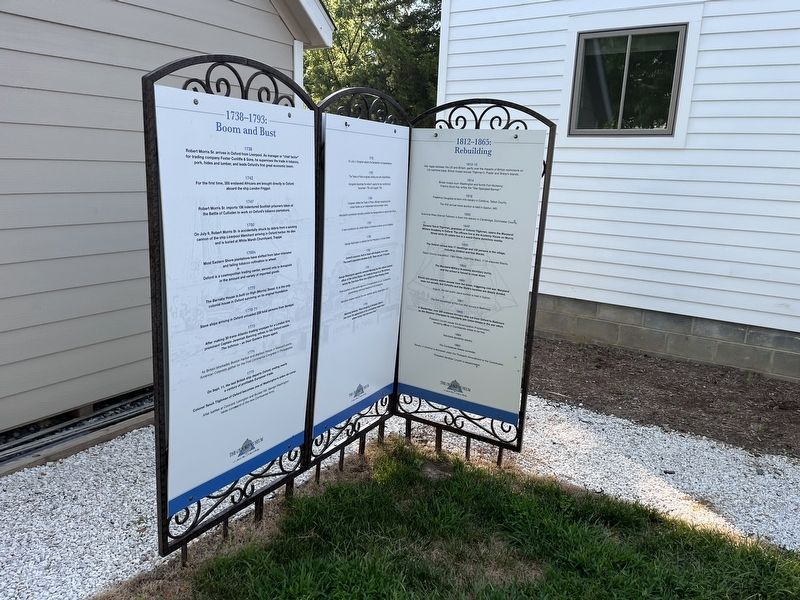Oxford in Talbot County, Maryland — The American Northeast (Mid-Atlantic)
1738-1793: Boom and Bust
The Oxford Museum
— A Special Place; A Special Heritage —
![1738-1793: Boom and Bust Marker [Panel 1]. Click for full size. 1738-1793: Boom and Bust Marker [Panel 1] image. Click for full size.](Photos6/675/Photo675144.jpg?8282022102400AM)
Photographed By Devry Becker Jones (CC0), August 27, 2022
1. 1738-1793: Boom and Bust Marker [Panel 1]
1738
Robert Morris Sr. arrives in Oxford from Liverpool. As manager or "chief factor" for trading company Foster Cunliffe & Sons, he supervises the trade in tobacco, pork, hides and lumber, and leads Oxford's first great economic boom.
1742
For the first time, 355 enslaved Africans are brought directly to Oxford aboard the ship London Friggot.
1747
Robert Morris Sr. imports 106 indentured Scottish prisoners taken at the Battle of Culloden to work on Oxford's tobacco plantations.
1750
On July 6, Robert Morris Sr. is accidentally struck by debris from a saluting cannon of the ship Liverpool Merchant arriving in Oxford harbor. He dies and is buried at White Marsh Churchyard, Trappe.
1760s
Most Eastern Shore plantations have shifted from labor-intensive and falling tobacco cultivation to wheat.
Oxford is a cosmopolitan trading center, second only to Annapolis in the amount and variety of imported goods.
1770
The Barnaby House is built on High (Morris) Street. It is the only colonial house in Oxford surviving on its original foundation.
1770-71
Slave ships arriving in Oxford unloaded 226 total persons from Senegal.
1773
After making 30 trans-Atlantic trading voyages for a London firm, prominent Captain Jeremiah Banning retires to his Oxford estate — The Isthmus — as their Eastern Shore agent.
1774
As Britain blockades Boston Harbor and deploys troops in Massachusetts, American Colonists gather for the First Continental Congress in Philadelphia.
1775
On Sept. 11, the last British ship departs Oxford, ending nearly a century of profitable European trade.
Colonel Trench Tilghman of Oxford becomes one of Washington's aides-de-camp.
After battles at Concord, Lexington and Bunker Hill, George Washington takes command of the new Continental Army.
1776
On July 4, Congress adopts the Declaration of Independence.
1783
The Treaty of Paris is signed, ending war with Great Britain.
Annapolis becomes the nation's capital for ten months from November 1783 until August 1784.
1784
Congress ratifies the Treaty of Paris, officially recognizing the United States as an independent and sovereign nation.
Maryland's constitution formally prohibits the transportation of slaves from Africa.
1787
A new constitution for United States of America is drawn up by Congress.
1789
George Washington is elected the first President of the United States.
1790
Oxford's
![1738-1793: Boom and Bust Marker [Panel 2]. Click for full size. 1738-1793: Boom and Bust Marker [Panel 2] image. Click for full size.](Photos6/675/Photo675145.jpg?8282022102500AM)
Photographed By Devry Becker Jones (CC0), August 27, 2022
2. 1738-1793: Boom and Bust Marker [Panel 2]
1791
George Washington appoints Jeremiah Banning the first official Customs officer of the United States. His Customs House is at The Isthmus, across the Tred Avon River from Oxford on Plain Dealing Creek.
Three quarters of the states approve 10 Amendments to the U.S. Constitution, guaranteeing individual freedoms to all Americans.
Maryland donates land for the new national capitol, Washington, D.C.
1793
Banning laments: "Poor drooping & forsaken Oxford… has more the appearnce of an uninhabited island than where human feet have ever trod."
Erected by The Oxford Museum.
Topics. This historical marker is listed in these topic lists: African Americans • Colonial Era • Government & Politics • Industry & Commerce • War, US Revolutionary • Waterways & Vessels. A significant historical date for this entry is July 6, 1738.
Location. 38° 41.343′ N, 76° 10.347′ W. Marker is in Oxford, Maryland, in Talbot County. Marker can be reached from the intersection of South Morris Street (Maryland Route 333) and Market Street, on the right when traveling north. Touch for map.
Other nearby markers. At least 8 other markers are within walking distance of this marker. 1900-1950: Holding On (here, next to this marker); 1870-1900: Oxford Booms Again (here, next to this marker); 1812-1865: Rebuilding (here, next to this marker); 1952-Present: Oxford Rises Again (here, next to this marker); Before There Was an Oxford (here, next to this marker); 1668-1710: Oxford's Beginnings (here, next to this marker); Remembering Ancestors: The Middle Passage in Oxford, Maryland (approx. ¼ mile away); The Robert Morris Inn (approx. ¼ mile away). Touch for a list and map of all markers in Oxford.
Additional keywords. human trafficking
Credits. This page was last revised on August 28, 2022. It was originally submitted on August 28, 2022, by Devry Becker Jones of Washington, District of Columbia. This page has been viewed 114 times since then and 20 times this year. Photos: 1, 2, 3. submitted on August 28, 2022, by Devry Becker Jones of Washington, District of Columbia.
